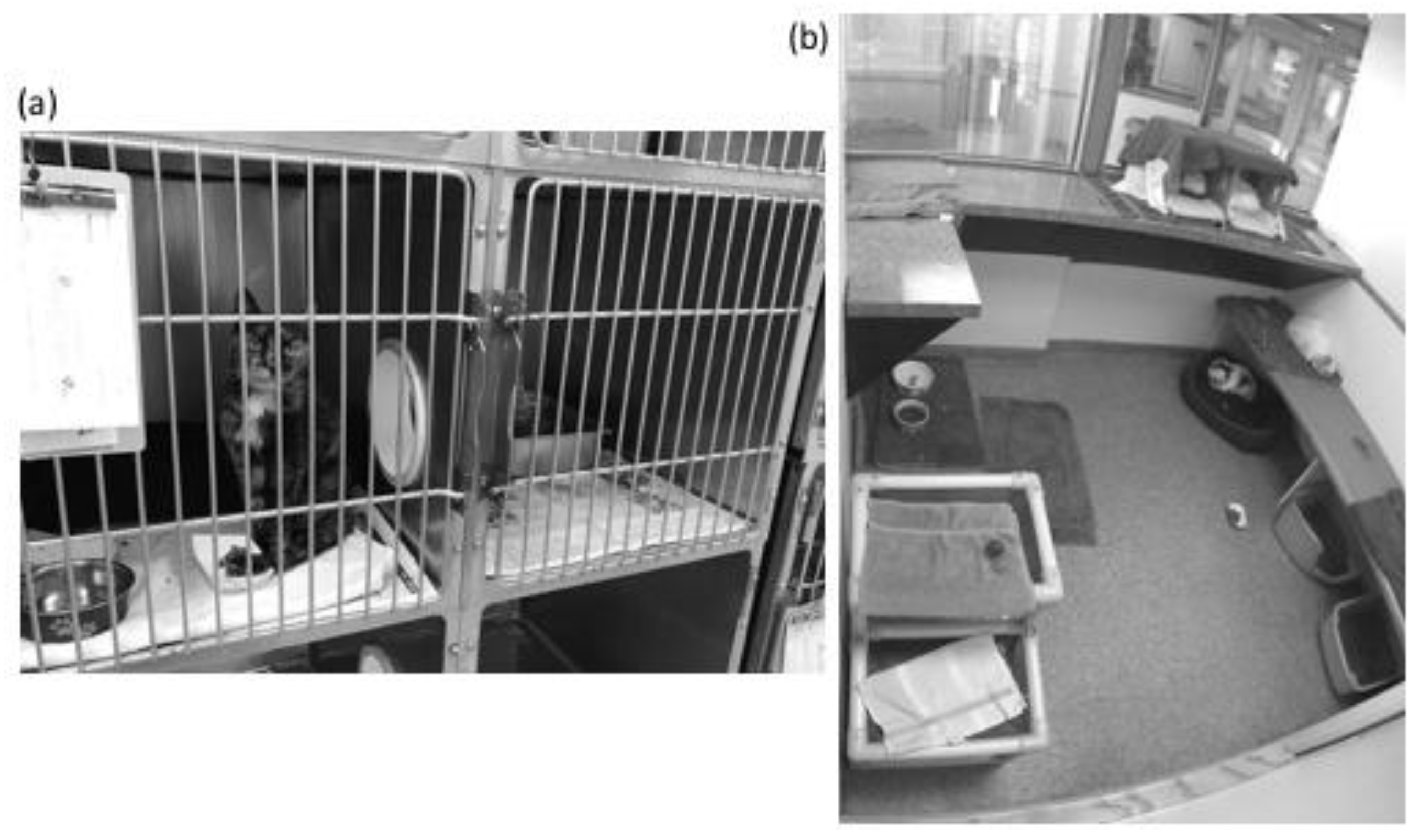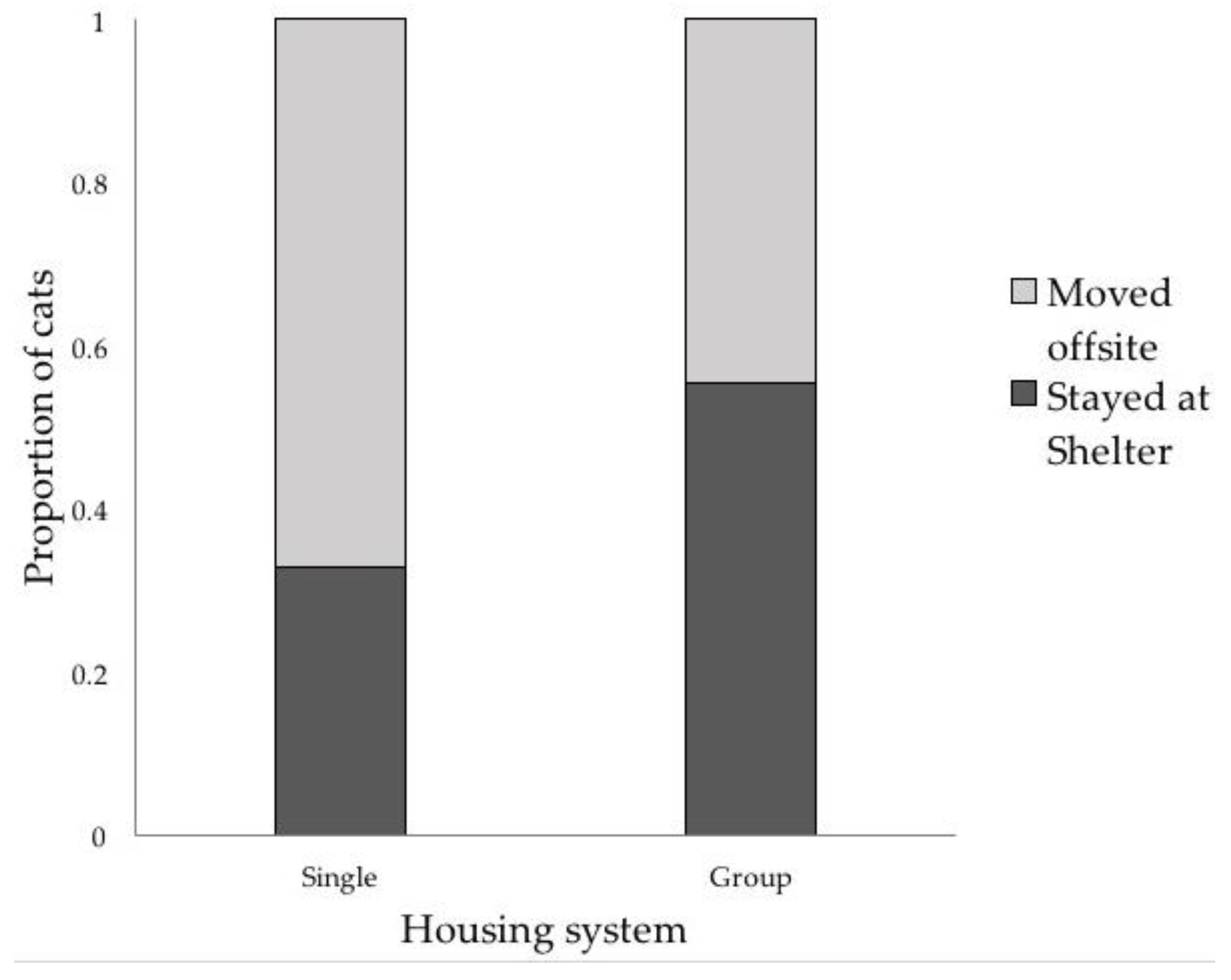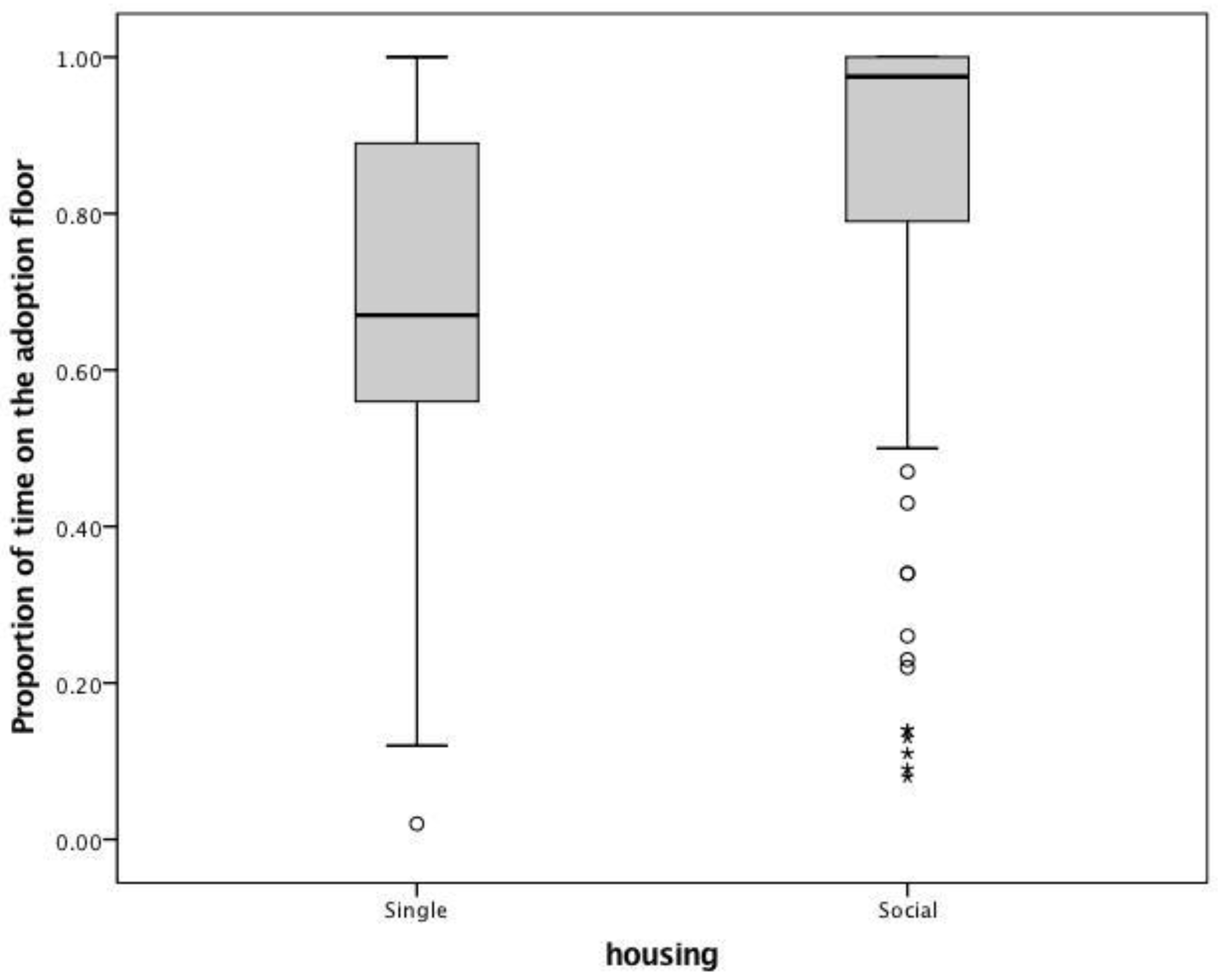A Comparison of Cats (Felis silvestris catus) Housed in Groups and Single Cages at a Shelter: A Retrospective Matched Cohort Study
Abstract
:Simple Summary
Abstract
1. Introduction
2. Materials and Methods
2.1. Subjects and Setting
2.2. Method for Matching
2.3. Shelter Experience Measures
- (a)
- Number of moves: The number of times a cat was moved from one cage or room to a different cage or room and remained in the new cage or room for more than 24 h. Therefore, a short-term move (for example, back to the clinic for a quick physical) was not counted. Given that moves are considered to be a stressful event for cats [21,23,32], differences in the number of moves between SH and GH cats could indicate the potential for higher stress in one group.
- (b)
- Average time spent in each location: Cats who were present longer at the shelter may experience more moves due to the overall amount of time. Therefore, we calculated the average time spent in each location as their length of stay (the number of days between their intake date and their outcome date, see below) divided by their number of moves (measure (a) above). This gives a measure of the average number of days per location, or the frequency with which the cat was moved.
- (c)
- Length of time on adoption floor: Since some of the moves (such as a move to the isolation unit, foster, or bite/scratch case) might result in a cat being moved off of the adoption floor, we looked at length of time on the adoption floor separately from these other measures. Time on the adoption floor has two implications for the cat. First, in order to be adopted, a cat typically needs to be visible to the public [15]. Second, the adoption floor tends to be much busier, with a great deal more human interaction than other areas.
- (d)
- Offsite moves: If a cat was marked as moving to an offsite location at any point during their length of stay, we categorized them as having been moved offsite. This was a 1/0 measure; cats who were moved offsite were scored as 1, cats who were not were scored as 0. Offsite moves increases time spent in transport, which is thought to cause stress [32].
- (e)
- Foster moves: If a cat was moved into a foster program, we marked them as moving to foster. This was a 1/0 measure; cats who were moved to foster were scored as 1, cats who were not were scored as 0. Foster moves also increases time spent in transport, since the cats are moved to the foster home and then back to the shelter for adoption. We excluded “foster to adopt” cats from this category if they were ultimately adopted into those same homes (and therefore did not return to the shelter for adoption). The reason for that is that in every case for our subjects, foster to adopt was used when the adopter was unable to officially adopt the cat until the cat finished a round of antibiotics and was cleared by the veterinarian for insurance reasons, which typically occurred 2–3 days after the cat became “foster to adopt”. Therefore, “foster to adopt’ was an artifact of an insurance policy and was qualitatively quite different from the cats needing true foster care for a period of time before being returned to the shelter for adoption.
- (f)
- Bite/scratch cases: Cats occasionally developed or exhibited behavior problems while in the shelter. The most severe of these were bite/scratch cases, as each time the cat was reported as biting or scratching someone, he or she would have to be held for a ten-day rabies watch without contact from visitors or volunteers. This has serious implications for the cat’s stay at the shelter including length of stay, enrichment, and housing setting. This was a 1/0 measure; cats who were bite/scratch cases were scored as 1, cats who were not were scored as 0.
2.4. Outcome Measures
- (a)
- Length of Stay (LoS): Length of stay was calculated as the entire time spent at the shelter from intake to outcome. Dates were determined by official dates logged in the PetPoint system upon admission to the shelter and outcome.
- (b)
- Live release: A cat was considered live release if he or she was adopted, returned to the original owner, or transferred to a private rescue or barn cat program. Cats that were euthanized or died while at the shelter due to other causes were not considered to be live release. Live release was a 1/0 measure; cats who were released alive were scored as 1, cats who were euthanized, or otherwise died while at the shelter were scored as 0.
- (c)
- Returns following adoption: For cats that left the shelter through a positive outcome (adoption or return to owner/guardian), we looked to see if the cat was returned within two years of adoption. Return was a 1/0 measure; cats who were returned in the two-year period were scored as 1, cats who were not returned were scored as 0.
2.5. Analysis
3. Results
3.1. The Cat’s Experience in the Shelter
3.2. Outcomes
4. Discussion
5. Conclusions
Supplementary Materials
Acknowledgments
Author Contributions
Conflicts of Interest
References
- The American Society for the Prevention of Cruelty to Animals: Pet Statistics. Available online: https://www.aspca.org/animal-homelessness/shelter-intake-and-surrender/pet-statistics (accessed on 7 December 2017).
- Rochlitz, I. Recommendations for the housing of cats in the home, in catteries and animal shelters, in laboratories and in veterinary surgeries. J. Feline Med. Surg. 1999, 1, 181–191. [Google Scholar] [CrossRef]
- Newbury, S.; Blinn, M.D.; Bushby, P.A.; Cox, C.B.; Dinnage, J.D.; Spindel, M. Guidelines for Standards of Care in Animal Shelters; Association of Shelter Veterinarians: Camas, WA, USA, 2010; Available online: www.sheltervet.org/assets/docs/shelter-standards-oct2011-wforward.pdf (accessed on 7 December 2017).
- Stella, J.; Croney, C.; Buffington, T. Environmental factors that affect the behavior and welfare of domestic cats (Felis silvestris catus) housed in cages. Appl. Anim. Behav. Sci. 2014, 160, 94–105. [Google Scholar] [CrossRef]
- Stella, J.L.; Lord, L.K.; Buffington, C.T. Sickness behaviors in response to unusual external events in healthy cats and cats with feline interstitial cystitis. J. Am. Vet. Med. Assoc. 2011, 238, 67–73. [Google Scholar] [CrossRef] [PubMed]
- Ellis, S.L. Environmental enrichment: Practical strategies for improving feline welfare. J. Feline Med. Surg. 2009, 11, 901–912. [Google Scholar] [CrossRef] [PubMed]
- Bradshaw, J.W. Sociality in cats: A comparative review. J. Vet. Behav. 2016, 11, 113–124. [Google Scholar] [CrossRef]
- Kessler, M.R.; Turner, D.C. Effects of density and cage size on stress in domestic cats (Felis silvestris catus) housed in animal shelters and boarding catteries. Anim. Welf. 1999, 8, 259–267. [Google Scholar]
- Ottway, D.S.; Hawkins, D.M. Cat housing in rescue shelters: A welfare comparison between communal and discrete-unit housing. Anim. Welf. 2003, 12, 173–189. [Google Scholar]
- Finka, L.R.; Ellis, S.L.; Stavisky, J. A critically appraised topic (CAT) to compare the effects of single and multi-cat housing on physiological and behavioural measures of stress in domestic cats in confined environments. BMC Vet. Res. 2014, 10, 73. [Google Scholar] [CrossRef] [PubMed] [Green Version]
- Loberg, J.M.; Lundmark, F. The effect of space on behaviour in large groups of domestic cats kept indoors. Appl. Anim. Behav. Sci. 2016, 182, 23–29. [Google Scholar] [CrossRef]
- Uetake, K.; Goto, A.; Koyama, R.; Kikuchi, R.; Tanaka, T. Effects of single caging and cage size on behavior and stress level of domestic neutered cats housed in an animal shelter. Anim. Sci. J. 2013, 84, 272–274. [Google Scholar] [CrossRef] [PubMed]
- Ahloy-Dallaire, J.; Espinosa, J.; Mason, G. Play and optimal welfare: Does play behaviour indicate the presence of positive affective states? Behav. Process. 2017. [Google Scholar] [CrossRef] [PubMed]
- Held, S.D.; Špinka, M. Animal play and animal welfare. Anim. Behav. 2011, 81, 891–899. [Google Scholar] [CrossRef]
- Fantuzzi, J.M.; Miller, K.A.; Weiss, E. Factors relevant to adoption of cats in an animal shelter. J. Appl. Anim. Welf. Sci. 2010, 13, 174–179. [Google Scholar] [CrossRef] [PubMed]
- Gourkow, N.; Fraser, D. The effect of housing and handling practices on the welfare, behaviour, and selection of domestic cats (Felis sylvestris catus) by adopters in an animal shelter. Anim. Welf. 2006, 15, 371–377. [Google Scholar]
- Crowell-Davis, S.L.; Curtis, T.M.; Knowles, R.J. Social organization in the cat: A modern understanding. J. Feline Med. Surg. 2004, 6, 19–28. [Google Scholar] [CrossRef] [PubMed]
- Bradshaw, J.W.S.; Hall, S.L. Affiliative behaviour of related and unrelated pairs of cats in catteries: A preliminary report. Appl. Anim. Behav. Sci. 1999, 3, 251–255. [Google Scholar] [CrossRef]
- Suchak, M.; Piombino, M.; Bracco, K. Predictors of proximity to others in colony housed shelter cats (Felis silvestris catus). Pet Behav. Sci. 2016, 2, 24–33. [Google Scholar] [CrossRef]
- Kry, K.; Casey, R. The effect of hiding enrichment on stress levels and behaviour of domestic cats (Felis sylvestris catus) in a shelter setting and the implications for adoption potential. Anim. Welf. 2007, 16, 375–383. [Google Scholar]
- Hurley, K.F. Feline infectious disease control in shelters. Vet. Clin. N. Am. Small 2005, 35, 21–37. [Google Scholar] [CrossRef] [PubMed]
- Kessler, M.R.; Turner, D.C. Socialization and stress in cats (Felis silvestris catus) housed singly and in groups in animal shelters. Anim. Welf. 1999, 8, 15–26. [Google Scholar]
- Kessler, M.R.; Turner, D.C. Stress and adaptation of cats (Felis silvestris catus) housed singly, in pairs and in groups in boarding catteries. Anim. Welf. 1997, 6, 243–254. [Google Scholar]
- Lichtsteiner, M.; Turner, D.C. Influence of indoor-cat group size and dominance rank on urinary cortisol levels. Anim. Welf. 2008, 17, 215–237. [Google Scholar]
- Ramos, D.; Reche-Junior, A.; Fragoso, P.L.; Palme, R.; Yanasse, N.K.; Gouvêa, V.R.; Mills, D.S. Are cats (Felis catus) from multi-cat households more stressed? Evidence from assessment of fecal glucocorticoid metabolite analysis. Physiol. Behav. 2013, 122, 72–75. [Google Scholar] [CrossRef] [PubMed]
- Arhant, C.; Wogritsch, R.; Troxler, J. Assessment of behavior and physical condition of shelter cats as animal-based indicators of welfare. J. Vet. Behav. 2015, 10, 399–406. [Google Scholar] [CrossRef]
- Foster, S.; Ijichi, C. The association between infrared thermal imagery of core eye temperature, personality, age, and housing in cats. Appl. Anim. Behav. Sci. 2017, 189, 79–84. [Google Scholar] [CrossRef]
- Brown, W.P.; Morgan, K.T. Age, breed designation, coat color, and coat pattern influenced the length of stay of cats at a no-kill shelter. J. Appl. Anim. Welf. Sci. 2015, 18, 169–180. [Google Scholar] [CrossRef] [PubMed]
- Bannasch, M.J.; Foley, J.E. Epidemiologic evaluation of multiple respiratory pathogens in cats in animal shelters. J. Feline Med. Surg. 2005, 7, 109–119. [Google Scholar] [CrossRef] [PubMed]
- McCobb, E.C.; Patronek, G.J.; Marder, A.; Dinnage, J.D.; Stone, M.S. Assessment of stress levels among cats in four animal shelters. J. Am. Vet. Med. Assoc. 2005, 226, 548–555. [Google Scholar] [CrossRef] [PubMed]
- Faul, F.; Erdfelder, E.; Lange, A.G.; Buchner, A. G*Power 3: A flexible statistical power analysis program for the social, behavioral, and biomedical sciences. Behav. Res. Methods 2007, 39, 175–191. [Google Scholar] [CrossRef] [PubMed]
- McCune, S. Caged Cats: Avoiding Problems and Providing Solutions; Newsletter of the Companion Animal Study Group; Waltham Centre for Pet Nutrition: Leicestershire, UK, 1994; Volume 7, pp. 1–9. [Google Scholar]
- Gouveia, K.; Magalhães, A.; de Sousa, L. The behaviour of domestic cats in a shelter: Residence time, density and sex ratio. Appl. Anim. Behav. Sci. 2011, 130, 53–59. [Google Scholar] [CrossRef]
- Stella, J.L.; Croney, C.C.; Buffington, C.T. Behavior and welfare of domestic cats housed in cages larger than U.S. norm. J. Appl. Anim. Welf. Sci. 2017, 20, 296–312. [Google Scholar] [CrossRef] [PubMed]
- Dybdall, K.; Strasser, R.; Katz, T. Behavioral differences between owner surrender and stray domestic cats after entering an animal shelter. Appl. Anim. Behav. Sci. 2007, 104, 85–94. [Google Scholar] [CrossRef]
- Gourkow, N.; Hamon, S.C.; Phillips, C.J.C. Effect of gentle stroking and vocalization on behaviour, mucosal immunity and upper respiratory disease in anxious shelter cats. Prev. Vet. Med. 2014, 117, 266–275. [Google Scholar] [CrossRef] [PubMed] [Green Version]
- Dybdall, K.; Strasser, R. Is there a bias against stray cats in shelters? People’s perception of Shelter cats and how it influences adoption time. Anthrozoös 2014, 27, 603–614. [Google Scholar] [CrossRef]
- Casey, R.A.; Vandenbussche, S.; Bradshaw, J.W.; Roberts, M.A. Reasons for relinquishment and return of domestic cats (Felis silvestris catus) to rescue shelters in the UK. Anthrozoös 2009, 22, 347–358. [Google Scholar] [CrossRef]
- Houpt, K.A. Domestic Animal Behavior for Veterinarians and Animal Scientists; Wiley-Blackwell: Ames, IA, USA, 2011; pp. 17–21. [Google Scholar]
- Levine, E.; Perry, P.; Scarlett, J.; Houpt, K.A. Intercat aggression in households following the introduction of a new cat. Appl. Anim. Behav. Sci. 2005, 90, 325–336. [Google Scholar] [CrossRef]
- Kommedal, A.T.; Wagner, D.; Hurley, K. The use of a shelter software a to track frequency and selected risk factors for feline upper respiratory infection. Animals 2015, 5, 161–172. [Google Scholar] [CrossRef] [PubMed]
- Suchak, M. Canisius College: Buffalo, NY, USA, unpublished observation. 2017.



| Continuous Variables | N | Median | Statistic | p-Value | - | - |
| Number of moves | SH: 110 GH: 110 | 2.00 2.00 | W = 11,567.5 | 0.21 | ||
| Average days per location | SH: 110 GH: 110 | 10.41 12.71 | W = 12,823.5 | 0.16 | ||
| Proportion of days on adoption floor | SH: 110 GH: 110 | 0.67 0.97 | W 14,844.00 | <0.001 | ||
| Categorical Variables | N | Percent | Statistic | p-Value | Odds Ratio | 95% CI |
| Offsite moves | SH: 110 GH: 110 | 67.27 44.55 | χ2 = 11.52 | 0.001 | 2.56 | 1.48–4.43 |
| Isolation moves | SH: 110 GH: 110 | 30.00 11.82 | χ2 = 11.00 | 0.001 | 3.20 | 1.58–6.49 |
| Bite/scratch cases | SH: 110 GH: 110 | 5.45 8.18 | χ2 = 0.64 | 0.42 | 0.65 | 0.22–1.89 |
| Continuous Variable | N | Median | Statistic | p-Value | - | - |
| Length of stay | SH: 110 GH: 110 | 24.50 26.00 | W = 12416.00 | 0.58 | ||
| Categorical Variables | N | Percent | Statistic | p-Value | Odds Ratio | 95% CI |
| Live release | SH: 110 GH: 110 | 96.36 92.73 | χ2 = 1.41 | 0.24 | 2.08 | 0.61–7.12 |
| Return | SH: 104 GH: 93 | 16.36 31.81 | χ2 = 2.32 | 0.13 | 0.54 | 0.25–1.20 |
© 2018 by the authors. Licensee MDPI, Basel, Switzerland. This article is an open access article distributed under the terms and conditions of the Creative Commons Attribution (CC BY) license (http://creativecommons.org/licenses/by/4.0/).
Share and Cite
Suchak, M.; Lamica, J. A Comparison of Cats (Felis silvestris catus) Housed in Groups and Single Cages at a Shelter: A Retrospective Matched Cohort Study. Animals 2018, 8, 29. https://doi.org/10.3390/ani8020029
Suchak M, Lamica J. A Comparison of Cats (Felis silvestris catus) Housed in Groups and Single Cages at a Shelter: A Retrospective Matched Cohort Study. Animals. 2018; 8(2):29. https://doi.org/10.3390/ani8020029
Chicago/Turabian StyleSuchak, Malini, and Jacalyn Lamica. 2018. "A Comparison of Cats (Felis silvestris catus) Housed in Groups and Single Cages at a Shelter: A Retrospective Matched Cohort Study" Animals 8, no. 2: 29. https://doi.org/10.3390/ani8020029




